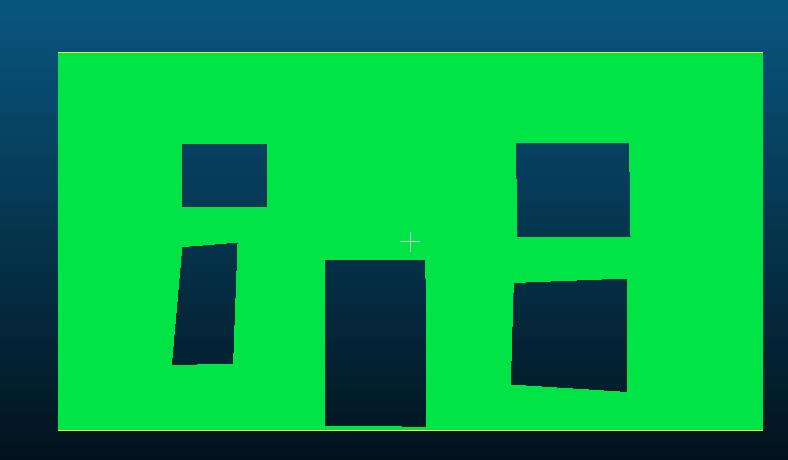[CGAL]带岛多边形三角化
Posted 岁寒然后知松柏之后凋也!
tags:
篇首语:本文由小常识网(cha138.com)小编为大家整理,主要介绍了[CGAL]带岛多边形三角化相关的知识,希望对你有一定的参考价值。
CGAL带岛多边形三角化,并输出(*.ply)格式的模型
模型输出的关键是节点和索引
#include <CGAL/Triangulation_vertex_base_with_id_2.h>
#include <CGAL/Triangulation_face_base_with_info_2.h>
因此注意这两个泛型,对比不带信息的
#include <CGAL/Triangulation_vertex_base_2.h>
#include <CGAL/Triangulation_face_base_2.h>,这两个增加了部分信息作为拓展。
这样Vertex_handle就可以读取这部分拓展的信息。
心得:CGAL的泛型机制真的很强大,拓展性很好。

// AxModelDelaunay.cpp : 定义控制台应用程序的入口点。 // #include "stdafx.h" #include "shapefil.h" #include "CGAL/exceptions.h" #include <CGAL/Exact_predicates_inexact_constructions_kernel.h> #include <CGAL/Constrained_Delaunay_triangulation_2.h> #include <CGAL/Triangulation_vertex_base_with_id_2.h> #include <CGAL/Triangulation_face_base_with_info_2.h> #include <CGAL/Polygon_2.h> #include <iostream> struct FaceInfo2 { FaceInfo2(){} int nesting_level; bool in_domain() { return nesting_level % 2 == 1; } }; typedef CGAL::Exact_predicates_inexact_constructions_kernel K; typedef CGAL::Triangulation_vertex_base_with_id_2<K> Vb; typedef CGAL::Triangulation_face_base_with_info_2<FaceInfo2, K> Fbb; typedef CGAL::Constrained_triangulation_face_base_2<K, Fbb> Fb; typedef CGAL::Triangulation_data_structure_2<Vb, Fb> TDS; typedef CGAL::Exact_predicates_tag Itag; typedef CGAL::Constrained_Delaunay_triangulation_2<K, TDS, Itag> CDT; typedef CDT::Point Point; typedef CGAL::Polygon_2<K> Polygon_2; typedef CDT::Vertex_handle Vertex_handle; void mark_domains(CDT& ct, CDT::Face_handle start, int index, std::list<CDT::Edge>& border) { if (start->info().nesting_level != -1){ return; } std::list<CDT::Face_handle> queue; queue.push_back(start); while (!queue.empty()){ CDT::Face_handle fh = queue.front(); queue.pop_front(); if (fh->info().nesting_level == -1){ fh->info().nesting_level = index; for (int i = 0; i < 3; i++){ CDT::Edge e(fh, i); CDT::Face_handle n = fh->neighbor(i); if (n->info().nesting_level == -1){ if (ct.is_constrained(e)) border.push_back(e); else queue.push_back(n); } } } } } //explore set of facets connected with non constrained edges, //and attribute to each such set a nesting level. //We start from facets incident to the infinite vertex, with a nesting //level of 0. Then we recursively consider the non-explored facets incident //to constrained edges bounding the former set and increase the nesting level by 1. //Facets in the domain are those with an odd nesting level. void mark_domains(CDT& cdt) { for (CDT::All_faces_iterator it = cdt.all_faces_begin(); it != cdt.all_faces_end(); ++it){ it->info().nesting_level = -1; } std::list<CDT::Edge> border; mark_domains(cdt, cdt.infinite_face(), 0, border); while (!border.empty()){ CDT::Edge e = border.front(); border.pop_front(); CDT::Face_handle n = e.first->neighbor(e.second); if (n->info().nesting_level == -1){ mark_domains(cdt, n, e.first->info().nesting_level + 1, border); } } } int _tmain(int argc, _TCHAR* argv[]) { //读取shp const char * pszShapeFile = "data\\\\walltest.shp"; SHPHandle hShp = SHPOpen(pszShapeFile, "r"); int nShapeType, nVertices; int nEntities = 0; double* minB = new double[4]; double* maxB = new double[4]; SHPGetInfo(hShp, &nEntities, &nShapeType, minB, maxB); printf("ShapeType:%d\\n", nShapeType); printf("Entities:%d\\n", nEntities); CDT cdt; for (int i = 0; i < nEntities; i++) { int iShape = i; SHPObject *obj = SHPReadObject(hShp, iShape); printf("--------------Feature:%d------------\\n", iShape); int parts = obj->nParts; int* partStart = obj->panPartStart; int verts = obj->nVertices; printf("nParts:%d\\n", parts); printf("nVertices:%d\\n", verts); for (int k = 0; k < parts; k++) { Polygon_2 polygon1; int fromIdx = partStart[k]; int toIdx = fromIdx; if (k<parts-1) { toIdx = partStart[k + 1]; } else { toIdx = verts; } for (size_t j = fromIdx; j < toIdx; j++) { double x = obj->padfX[j]; double y = obj->padfY[j]; //Point_2 pt(x, y); printf("%f,%f;", x, y); polygon1.push_back(Point(x, y)); } cdt.insert_constraint(polygon1.vertices_begin(), polygon1.vertices_end(), true); } printf("\\n"); } //construct two non-intersecting nested polygons //Polygon_2 polygon1; //polygon1.push_back(Point(0, 0)); //polygon1.push_back(Point(2, 0)); //polygon1.push_back(Point(2, 2)); //polygon1.push_back(Point(0, 2)); //Polygon_2 polygon2; //polygon2.push_back(Point(0.5, 0.5)); //polygon2.push_back(Point(1.5, 0.5)); //polygon2.push_back(Point(1.5, 1.5)); //polygon2.push_back(Point(0.5, 1.5)); ////Insert the polygons into a constrained triangulation //CDT cdt; //cdt.insert_constraint(polygon1.vertices_begin(), polygon1.vertices_end(), true); //cdt.insert_constraint(polygon2.vertices_begin(), polygon2.vertices_end(), true); //Mark facets that are inside the domain bounded by the polygon mark_domains(cdt); FILE *ply = fopen("data\\\\floorpeint.ply", "w"); int idx = 0; for (CDT::Vertex_iterator v = cdt.vertices_begin(); v != cdt.vertices_end(); ++v) { Vertex_handle vv = v->handle(); vv->id() = idx; idx++; } int count = 0; for (CDT::Finite_faces_iterator fit = cdt.finite_faces_begin(); fit != cdt.finite_faces_end(); ++fit) { if (fit->info().in_domain()) { ++count; for (int i = 0; i < 3; i++) { Vertex_handle vert = fit->vertex(i); int x=vert->id(); std::cout << "The Id is " << x << std::endl; CDT::Edge ed(fit, i); ed.second; } } } if (ply) { fprintf(ply, "ply\\nformat %s 1.0\\n", "ascii"); fprintf(ply, "element vertex %d\\n",idx ); fprintf(ply, "property float x\\n"); fprintf(ply, "property float y\\n"); fprintf(ply, "property float z\\n"); fprintf(ply, "element face %d\\n", count); fprintf(ply, "property list uint8 int32 vertex_indices\\n"); fprintf(ply, "end_header\\n"); for (CDT::Vertex_iterator v = cdt.vertices_begin(); v != cdt.vertices_end(); ++v) { Vertex_handle vv = v->handle(); double x = vv->point().x(); double y = vv->point().y(); fprintf(ply, "%f %f %f\\n", x, y, 0.0); } for (CDT::Finite_faces_iterator fit = cdt.finite_faces_begin(); fit != cdt.finite_faces_end(); ++fit) { if (fit->info().in_domain()) { Vertex_handle vertId0 = fit->vertex(0); Vertex_handle vertId1 = fit->vertex(1); Vertex_handle vertId2 = fit->vertex(2); int id0 = vertId0->id(); int id1 = vertId1->id(); int id2 = vertId2->id(); fprintf(ply, "%d %d %d %d\\n", 3, id0, id1, id2); } } } std::cout << "There are " << count << " facets in the domain." << std::endl; system("pause"); return 0; }
效果图


以上是关于[CGAL]带岛多边形三角化的主要内容,如果未能解决你的问题,请参考以下文章
